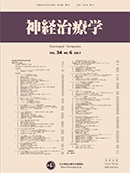37 巻, 1 号
選択された号の論文の19件中1~19を表示しています
- |<
- <
- 1
- >
- >|
-
2020 年37 巻1 号 p. 1
発行日: 2020年
公開日: 2020/07/21
PDF形式でダウンロード (194K)
特集 Lewy小体病の診断と治療の新たな展開
-
2020 年37 巻1 号 p. 3
発行日: 2020年
公開日: 2020/07/21
PDF形式でダウンロード (217K) -
2020 年37 巻1 号 p. 4-9
発行日: 2020年
公開日: 2020/07/21
PDF形式でダウンロード (1209K) -
2020 年37 巻1 号 p. 10-15
発行日: 2020年
公開日: 2020/07/21
PDF形式でダウンロード (409K) -
2020 年37 巻1 号 p. 16-19
発行日: 2020年
公開日: 2020/07/21
PDF形式でダウンロード (1122K) -
2020 年37 巻1 号 p. 20-27
発行日: 2020年
公開日: 2020/07/21
PDF形式でダウンロード (573K) -
2020 年37 巻1 号 p. 28-31
発行日: 2020年
公開日: 2020/07/21
PDF形式でダウンロード (424K) -
2020 年37 巻1 号 p. 32-38
発行日: 2020年
公開日: 2020/07/21
PDF形式でダウンロード (507K)
原著
-
2020 年37 巻1 号 p. 39-42
発行日: 2020年
公開日: 2020/07/21
PDF形式でダウンロード (1420K) -
2020 年37 巻1 号 p. 43-46
発行日: 2020年
公開日: 2020/07/21
PDF形式でダウンロード (460K) -
2020 年37 巻1 号 p. 47-50
発行日: 2020年
公開日: 2020/07/21
PDF形式でダウンロード (324K)
神経治療最前線 海外学会参加報告
-
2020 年37 巻1 号 p. 51-52
発行日: 2020年
公開日: 2020/07/21
PDF形式でダウンロード (882K) -
2020 年37 巻1 号 p. 53-54
発行日: 2020年
公開日: 2020/07/21
PDF形式でダウンロード (1397K) -
2020 年37 巻1 号 p. 55-57
発行日: 2020年
公開日: 2020/07/21
PDF形式でダウンロード (1402K) -
2020 年37 巻1 号 p. 58-59
発行日: 2020年
公開日: 2020/07/21
PDF形式でダウンロード (629K)
-
2020 年37 巻1 号 p. 61-104
発行日: 2020年
公開日: 2020/07/21
PDF形式でダウンロード (8770K)
-
2020 年37 巻1 号 p. 105-108
発行日: 2020年
公開日: 2020/07/21
PDF形式でダウンロード (319K) -
2020 年37 巻1 号 p. 109
発行日: 2020年
公開日: 2020/07/21
PDF形式でダウンロード (144K) -
2020 年37 巻1 号 p. 110
発行日: 2020年
公開日: 2020/07/21
PDF形式でダウンロード (139K)
- |<
- <
- 1
- >
- >|
